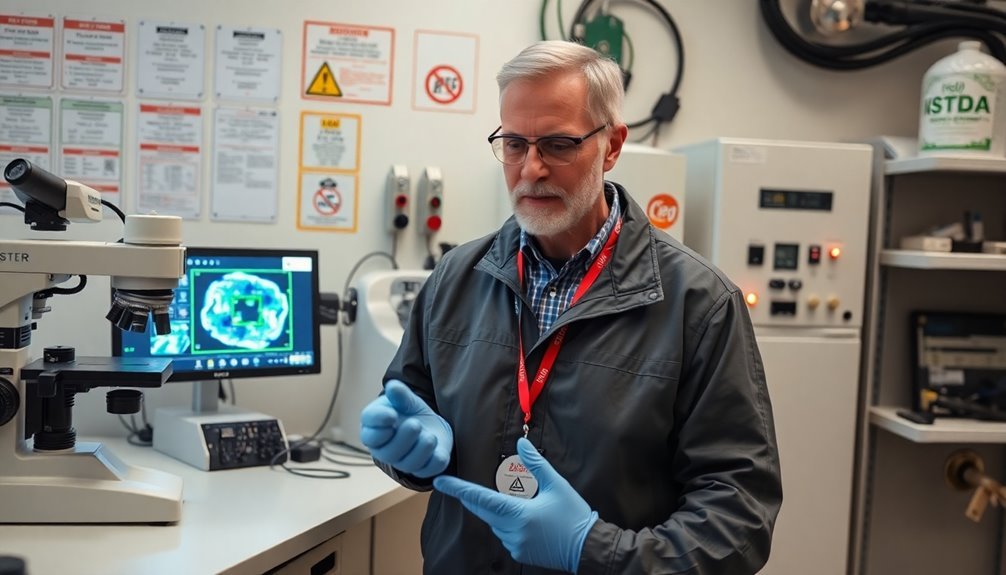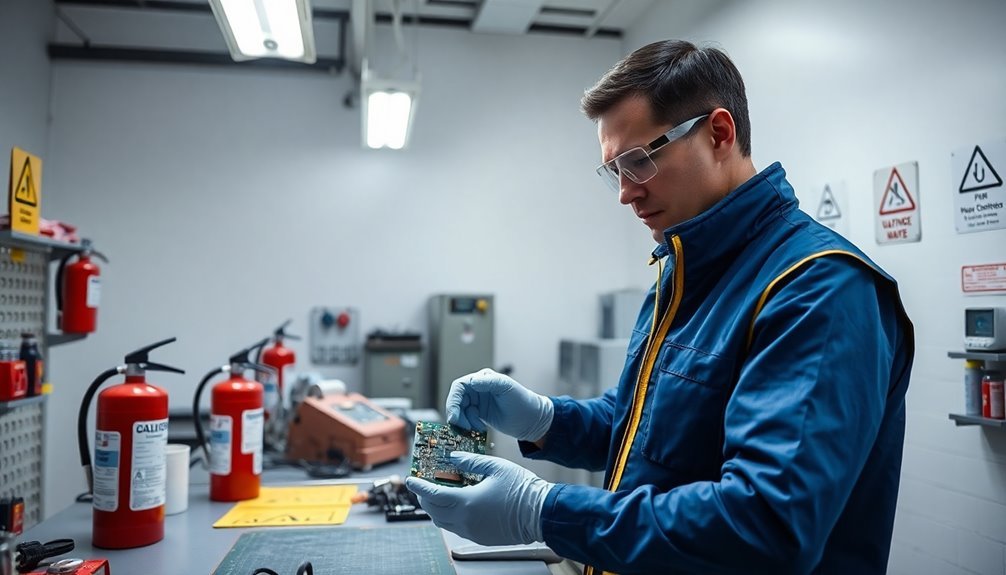To become an Electronics Safety Manager, you'll need a bachelor's degree in engineering, environmental safety, or a related field, plus key certifications like CSM or CHMM. You must master risk assessment, emergency response, and compliance management while developing expertise in electronics manufacturing hazards. Focus on building strong documentation skills and staying current with industry standards like RoHS and CE marking requirements. Career growth starts with entry-level safety positions, advancing to management roles with experience. With average salaries reaching $70,374 and projected industry growth of 9%, this career path offers promising opportunities. The following insights will equip you for success in this dynamic field.
Essential Educational Requirements and Certifications

When pursuing a career as an electronics safety manager, you'll need to meet specific educational and certification requirements. Start by earning your bachelor's degree in engineering, environmental safety, or a related field, ensuring your coursework includes hazardous materials management and business management classes.
You'll also need specialized education focused on electronics safety protocols and industry-specific requirements. Demonstrating attention to detail through documentation and record-keeping is essential for regulatory compliance.
Your education alone won't suffice; you'll need three to five years of hands-on safety experience in the electronics industry. If you're aiming for a management position without prior leadership experience, you may need additional years of experience or qualifications to compensate.
Consider obtaining relevant certifications to enhance your credentials. The Certified Safety Manager (CSM) certification provides thorough training, while the Certified Hazardous Materials Manager (CHMM) focuses on handling dangerous materials common in electronics manufacturing.
For higher-level positions, pursue the Certified Safety and Health Manager (CSHM) certification, which requires a bachelor's degree and five years of leadership experience.
Remember to maintain your certifications through continuing education units (CEUs) and stay current with industry-specific updates and best practices. Most certifications require renewal every three years through refresher courses and examinations.
Core Safety Management Skills
As a safety manager in electronics, you'll need to master three fundamental areas: risk assessment for identifying potential hazards, emergency response leadership for guiding teams during critical situations, and thorough documentation management to maintain safety records. Making quick decisions requires strong judgment during critical incidents.
You must regularly evaluate workplace conditions, understand technical risks specific to electronics manufacturing, and implement preventive measures based on your findings.
Your expertise in these core skills will enable you to protect workers, meet compliance requirements, and maintain a robust safety program that adapts to changing industry standards.
Risk Assessment Fundamentals
A solid understanding of risk assessment fundamentals forms the backbone of effective safety management in electronics manufacturing. As a safety manager, you'll need to master the systematic process of identifying hazards, evaluating risks, and implementing control measures to protect workers and facilities. Failure to recognize hazards can result in increased workplace illnesses, injuries, and accidents that impact productivity.
This structured approach helps you prevent accidents and create a safer work environment.
To effectively conduct risk assessments in electronics manufacturing, you'll need to:
- Systematically identify potential hazards specific to electronics work, including electrical risks, chemical exposures, and ergonomic concerns.
- Evaluate the severity and likelihood of each identified hazard using data-driven methods and historical trends.
- Implement and document appropriate control measures, ranging from engineering controls to personal protective equipment.
Your role requires continuous monitoring and updating of risk assessments as new equipment, processes, or materials are introduced. You'll need to use specialized tools and software for advanced hazard analysis while ensuring compliance with industry standards.
Risk assessment isn't a one-time task – it's an ongoing process that requires regular reviews and updates to maintain its effectiveness in preventing workplace incidents.
Emergency Response Leadership
Three critical responsibilities define your role in emergency response leadership: commanding incidents, coordinating teams, and maintaining clear communication channels. As an electronics safety manager, you'll need to develop thorough emergency response plans while guaranteeing your team understands their specific roles during crisis situations.
You must master both operational knowledge and analytical skills to effectively identify hazards and implement mitigation strategies. Focus on developing your communication abilities, as you'll need to provide clear, concise instructions during emergencies and maintain open lines of communication with all stakeholders, including external first responders. Consider assembling a team with diverse departmental representatives to ensure comprehensive emergency coverage.
To strengthen your emergency response leadership, conduct regular training sessions and drills that simulate various emergency scenarios. Use these exercises to assess your team's readiness and refine your response protocols.
Make sure you're familiar with relevant regulatory frameworks and safety management systems, including NIMS/ICS requirements.
Prioritize the development of a strong safety culture by integrating emergency response protocols into your daily operations. Regularly review and update your emergency plans based on lessons learned, and guarantee your team receives annual refresher training to maintain their emergency response capabilities.
Safety Documentation Management
Building on strong emergency response leadership, effective safety documentation management forms the backbone of your safety program. You'll need to establish a centralized system that makes all safety documents easily accessible while complying with OSHA regulations and industry standards. This includes maintaining detailed records of incidents, safety plans, training logs, and equipment maintenance schedules.
To create an effective documentation system, focus on these critical elements:
- Develop clear, detailed procedures that outline safety preparations, precautions, and contingency plans for each task in your electronics facility. Creating detailed documents with technical diagrams and images helps workers better understand and follow safety procedures.
- Implement a unified digital platform that allows quick retrieval of documents during audits or emergencies while promoting collaboration among team members.
- Establish a regular review schedule to keep documentation current with changing workplace conditions and regulatory requirements.
You'll need to document every safety incident thoroughly, including root causes, corrective actions, and preventive measures.
Don't forget to maintain records of regular equipment inspections and predictive maintenance schedules.
By implementing secure cloud-based solutions, you can guarantee transparency while protecting sensitive information.
Remember to regularly validate your documentation system through periodic check-ins and updates to maintain its effectiveness.
Industry Experience and Career Path

You'll need a bachelor's degree in engineering and a strong understanding of electronics principles to land an entry-level position in electronics safety management.
As you progress in your career, you can advance from safety coordinator to specialist and ultimately to manager roles by gaining certifications like CSP or CPSM and developing leadership experience. Safety engineers earn a median annual wage of $103,690, making it a financially rewarding career path.
The field offers diverse specialization opportunities across industries such as healthcare, telecommunications, and defense, each requiring specific safety expertise and continuous adaptation to new technologies.
Entry-Level Position Requirements
Becoming an Electronics Safety Manager requires a solid foundation of education and experience, even at the entry level. You'll need at least a bachelor's degree in electronics, electrical engineering, or occupational health and safety, though some employers may prefer candidates with a master's degree. Much of your expertise will come through on-the-job training in entry-level positions.
Professional certifications like CSP, OHST, ASP, or NEBOSH can substantially strengthen your qualifications and demonstrate your expertise in the field.
To position yourself for success in this role, you'll want to focus on these key requirements:
- Educational credentials that combine technical knowledge with safety principles, which can include an associate degree for electronics technicians or advanced degrees for management positions.
- Professional certifications that validate your expertise and commitment to safety standards, particularly those recognized within the electronics industry.
- Background screening clearance, which is often mandatory due to the critical nature of safety management positions.
While entry-level positions may not require extensive experience, internships and hands-on training can provide valuable practical knowledge. You'll find that many employers value a combination of technical understanding and safety management skills, making it essential to develop both aspects early in your career.
Career Growth Milestones
Professional growth in electronics safety management follows a clear trajectory spanning multiple decades. During your first 6-10 years, you'll focus on building core competencies, gaining specialized certifications like CSP or OHST, and developing essential communication and leadership skills. Regular safety audits and inspections will become a crucial part of your early role development. This period is vital for finding mentors who can help enhance your business acumen and increase your visibility among executives.
As you progress into your second decade (11-15 years), you'll face important career path decisions between technical and managerial tracks. You'll expand your influence by taking on broader EHS responsibilities, conducting training sessions, and developing strategic safety initiatives. Your expertise will start catching the attention of executive leadership.
In years 16-20, you'll likely advance to senior leadership positions with global accountability. You'll oversee multiple sites, mentor other safety professionals, and make strategic decisions that shape your organization's safety culture.
Your ultimate career milestone involves achieving full control of safety and environmental management programs, where you'll influence industry standards and create sustainable safety systems. At this level, you'll focus on leaving a lasting legacy through improved safety practices and cultural transformation.
Industry Specialization Opportunities
Electronics safety professionals have diverse opportunities to specialize across multiple sectors, each offering unique career trajectories and technical challenges.
You'll need to combine your technical expertise with industry-specific knowledge to succeed in your chosen specialization, whether it's consumer electronics, medical devices, or aerospace systems.
1. Choose your specialization based on your interests and background.
If you've got a strong automotive background, you'll excel in vehicle electronics safety. If medical technology fascinates you, consider focusing on medical device safety compliance and regulatory standards.
2. Develop sector-specific expertise by obtaining relevant certifications and hands-on experience.
You'll need OSHA certification and thorough knowledge of industry standards, plus continuous training to stay current with evolving technologies and regulations.
3. Build your career path by mastering both technical and soft skills.
You'll be responsible for risk assessment, safety protocols, and project management, while coordinating with regulatory bodies and certification agencies.
Each specialization requires a bachelor's degree in electronics or safety engineering, but your success will depend on how well you combine your educational foundation with practical experience and industry-specific knowledge.
Safety Standards and Compliance
Several critical safety standards and regulations govern the electronics industry, shaping how devices must be designed, tested, and marketed.
As an Electronics Safety Manager, you'll need to master key regulations like the EU RoHS Directive, which restricts hazardous substances in electronic equipment, and FCC regulations that control electromagnetic interference and radio frequency emissions.
You'll be responsible for ensuring compliance with CE marking requirements and the Low Voltage Directive (LVD), which are mandatory for products entering the European market.
Your role involves overseeing electrical safety testing, including high voltage tests, insulation resistance checks, and ground continuity assessments.
To maintain compliance, you'll need to identify applicable standards for your products and coordinate testing through accredited laboratories. You're responsible for managing documentation, including test reports and technical files, while ensuring proper labeling with FCC and CE marks as required.
You'll also oversee ongoing compliance monitoring, keeping track of regulatory changes and updating product documentation accordingly. Regular reviews of product safety performance and immediate attention to any compliance issues will be vital aspects of your role.
Leadership in Electronics Manufacturing

Successful leadership in electronics manufacturing requires five core competencies: strategic thinking, effective communication, emotional intelligence, adaptability, and collaboration. As a safety manager, you'll need to combine these qualities with strong decision-making skills and industry expertise to guide your team effectively while maintaining safety standards.
To excel in your leadership role, you'll want to develop these essential abilities:
- Make quick, data-driven decisions while maintaining flexibility to adapt to technological changes and market trends.
- Build strong relationships through effective negotiation with suppliers, partners, and team members.
- Identify and solve problems efficiently to prevent production threats while keeping safety at the forefront.
You'll need to stay current with industry developments through continuous learning and professional development. Take advantage of mentorship opportunities, training programs, and industry connections to enhance your leadership capabilities.
Your role involves both technical expertise and people management – you're not just overseeing safety protocols, but also empowering your team to maintain high safety standards while achieving manufacturing excellence.
Focus on creating a positive work environment where safety consciousness and productivity go hand in hand.
Salary and Growth Opportunities
Building on your leadership capabilities, you'll want to understand the financial rewards and advancement paths available in electronics safety management.
As an Electrical Safety Specialist, you can expect to earn between $57,520 and $80,528 annually, with an average salary of $70,374 at companies like Electrical Safety Specialists. However, your earnings can vary considerably based on your employer, with companies like Urban City Designs offering up to $104,784 annually.
Your career growth potential is substantial, with multiple paths for advancement. You can progress to leadership positions like team lead or safety director, especially after obtaining certifications such as CSP or CPSM.
If you're entrepreneurially minded, you can shift into consulting or start your own safety engineering firm. The industry outlook is particularly promising, with a projected 9% growth rate through 2033 and approximately 19,000 annual job openings.
To maximize your earning potential, consider specializing in high-demand sectors like automotive, aerospace, or medical devices. Professional development through organizations like ASSE or PSES will enhance your marketability.
Additionally, pursuing a Professional Engineering (PE) license can qualify you for higher-paying leadership roles and independent work opportunities.
Frequently Asked Questions
How Do You Handle Resistance From Senior Management Regarding Safety Investments?
You'll need to present data-driven financial benefits, emphasize risk management, and engage senior leaders actively. Address their concerns directly, showcase the $4.41 ROI per dollar spent, and maintain open communication channels.
What Emergency Protocols Should Be Prioritized in Small Electronics Manufacturing Facilities?
You should prioritize evacuation procedures, electrical hazard protocols, fire detection systems, and clear emergency communication channels. Don't forget to maintain essential first aid supplies and train staff on proper response procedures.
Can Language Barriers Affect Safety Training Effectiveness in Multinational Manufacturing Teams?
Yes, you'll face significant safety risks when language barriers exist. They can reduce training effectiveness by 25%, leading to accidents. You should provide multilingual training materials and use visual aids to guarantee everyone's understanding.
How Often Should Safety Equipment Be Upgraded in Electronics Manufacturing Plants?
You should upgrade your safety equipment annually for routine updates and immediately when regulations change, technology advances substantially, or risk assessments indicate a need. Don't wait for equipment failure before upgrading.
What Mental Health Support Should Safety Managers Provide to Stressed Employees?
You should provide counseling services, establish stress management programs, offer flexible work arrangements, and guarantee access to mental health resources. Don't forget to create open dialogue channels for employees to discuss their concerns.
In Summary
You've now got a thorough roadmap to becoming an electronics safety manager. Whether you're pursuing certifications, developing leadership skills, or mastering safety protocols, your dedication will pay off. Stay current with industry standards, build your expertise, and network within manufacturing circles. With the growing demand for safety professionals, you'll find abundant opportunities for career growth and competitive compensation in this rewarding field.





Leave a Reply